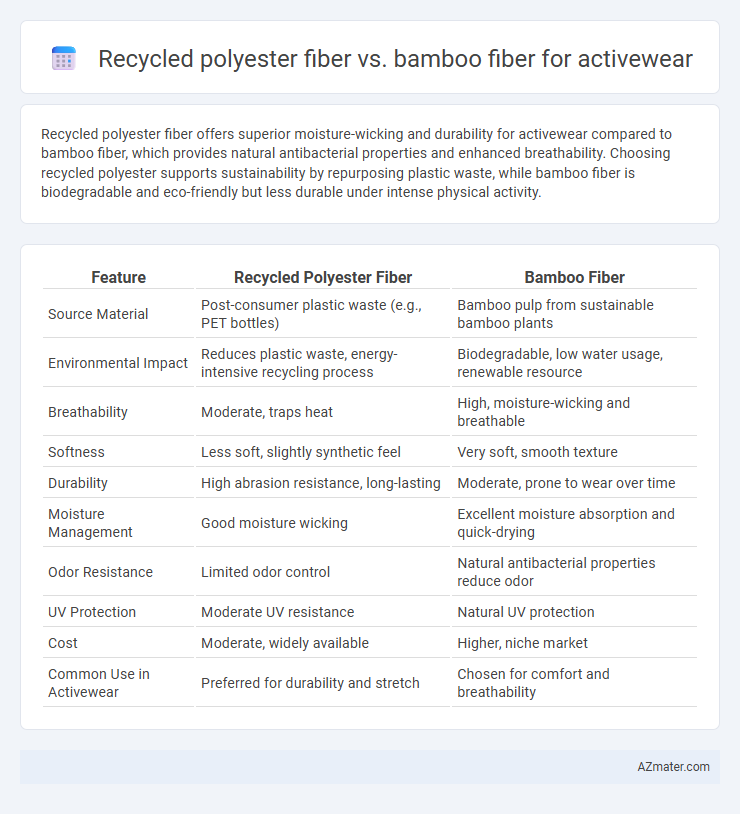Recycled polyester fiber offers superior moisture-wicking and durability for activewear compared to bamboo fiber, which provides natural antibacterial properties and enhanced breathability. Choosing recycled polyester supports sustainability by repurposing plastic waste, while bamboo fiber is biodegradable and eco-friendly but less durable under intense physical activity.
Table of Comparison
| Feature | Recycled Polyester Fiber | Bamboo Fiber |
|---|---|---|
| Source Material | Post-consumer plastic waste (e.g., PET bottles) | Bamboo pulp from sustainable bamboo plants |
| Environmental Impact | Reduces plastic waste, energy-intensive recycling process | Biodegradable, low water usage, renewable resource |
| Breathability | Moderate, traps heat | High, moisture-wicking and breathable |
| Softness | Less soft, slightly synthetic feel | Very soft, smooth texture |
| Durability | High abrasion resistance, long-lasting | Moderate, prone to wear over time |
| Moisture Management | Good moisture wicking | Excellent moisture absorption and quick-drying |
| Odor Resistance | Limited odor control | Natural antibacterial properties reduce odor |
| UV Protection | Moderate UV resistance | Natural UV protection |
| Cost | Moderate, widely available | Higher, niche market |
| Common Use in Activewear | Preferred for durability and stretch | Chosen for comfort and breathability |
Overview of Recycled Polyester Fiber
Recycled polyester fiber, derived from post-consumer plastic bottles and industrial polyester waste, offers a sustainable alternative by reducing landfill use and energy consumption compared to virgin polyester production. Its moisture-wicking properties, durability, and resistance to shrinking make it ideal for high-performance activewear designed for intense physical activity. The closed-loop recycling process used to create recycled polyester significantly lowers carbon emissions, aligning with eco-friendly and circular economy practices in the textile industry.
Bamboo Fiber: A Natural Alternative
Bamboo fiber offers a sustainable and biodegradable alternative to recycled polyester fiber for activewear, known for its breathability and moisture-wicking properties that enhance comfort during physical activity. Its natural antibacterial qualities reduce odor, making it ideal for intensive workouts and prolonged wear. Bamboo cultivation requires less water and pesticides compared to conventional cotton, boosting its eco-friendly profile in sustainable activewear production.
Environmental Impact: Recycled Polyester vs Bamboo Fiber
Recycled polyester fiber significantly reduces plastic waste by repurposing PET bottles, cutting down energy use and CO2 emissions compared to virgin polyester production. Bamboo fiber, derived from bamboo plants, offers natural biodegradability and requires less water and pesticides than cotton, but its environmental impact depends heavily on the chemical-intensive processing methods used to convert bamboo into fabric. Choosing between recycled polyester and bamboo fiber for activewear involves balancing the benefits of waste reduction and durability in recycled polyester against the renewable resource advantages and biodegradability of bamboo fiber.
Moisture-Wicking and Breathability Comparison
Recycled polyester fiber exhibits superior moisture-wicking properties compared to bamboo fiber, rapidly drawing sweat away from the skin to keep wearers dry during intense workouts. Bamboo fiber offers excellent natural breathability due to its micro-gaps and micro-holes, promoting air circulation and thermal regulation in activewear. When prioritizing performance in moisture management and breathability, recycled polyester is favored for high-intensity activities, while bamboo fiber suits moderate exertion with added comfort and eco-friendly appeal.
Durability and Longevity in Activewear
Recycled polyester fiber offers exceptional durability and retains its shape and color after extensive use and multiple washes, making it ideal for activewear designed for high-intensity workouts. Bamboo fiber, while breathable and moisture-wicking, tends to degrade faster under continuous friction and frequent laundering, reducing its longevity. Choosing recycled polyester ensures longer-lasting activewear with sustained performance and wear resistance over time.
Comfort and Skin Sensitivity Considerations
Recycled polyester fiber offers excellent moisture-wicking properties and durability, making it ideal for activewear that requires high performance and quick drying. Bamboo fiber is naturally hypoallergenic and antimicrobial, providing superior softness and breathability, which benefits sensitive skin during prolonged wear. Both fibers excel in comfort, but bamboo fiber is often preferred for individuals with skin sensitivity due to its natural, chemical-free composition.
Cost and Market Availability
Recycled polyester fiber is generally more cost-effective and widely available in the activewear market due to extensive recycling infrastructure and established production processes. Bamboo fiber, while eco-friendly, tends to be pricier and less common because of limited large-scale manufacturing and slower supply chain development. Market demand for sustainable activewear is driving increased availability of both fibers, but recycled polyester currently dominates in terms of both cost efficiency and accessibility.
Performance in High-Intensity Activities
Recycled polyester fiber offers superior moisture-wicking and quick-drying properties, making it ideal for high-intensity activities that demand sustained performance and durability. Bamboo fiber provides natural breathability and antibacterial benefits but tends to retain more moisture, potentially reducing comfort during intense workouts. For activewear designed for vigorous exercise, recycled polyester fiber generally delivers enhanced performance by maintaining dryness and resilience under repeated stress.
Certification and Sustainability Standards
Recycled polyester fiber used in activewear often carries certifications such as Global Recycled Standard (GRS) and OEKO-TEX(r), ensuring verified recycled content and the absence of harmful substances, while bamboo fiber typically meets standards like OEKO-TEX(r) and Global Organic Textile Standard (GOTS) when processed sustainably. Recycled polyester leverages post-consumer waste, reducing reliance on virgin petroleum, whereas bamboo fiber's sustainability depends heavily on chemical-free processing methods that maintain its biodegradability and low water usage. Both fibers support eco-friendly activewear, but recycled polyester excels in circular economy integration, whereas bamboo fiber offers natural biodegradability under certified sustainable practices.
Which Fiber Is Better for Activewear Brands?
Recycled polyester fiber offers superior moisture-wicking and durability, making it ideal for high-performance activewear brands prioritizing sustainability and long-lasting wear. Bamboo fiber provides excellent breathability and natural antibacterial properties, appealing to eco-conscious consumers seeking softness and odor resistance. Activewear brands targeting eco-friendly innovation and technical performance often prefer recycled polyester, while those emphasizing natural comfort and biodegradability lean toward bamboo fiber.

Infographic: Recycled polyester fiber vs Bamboo fiber for Activewear
 azmater.com
azmater.com